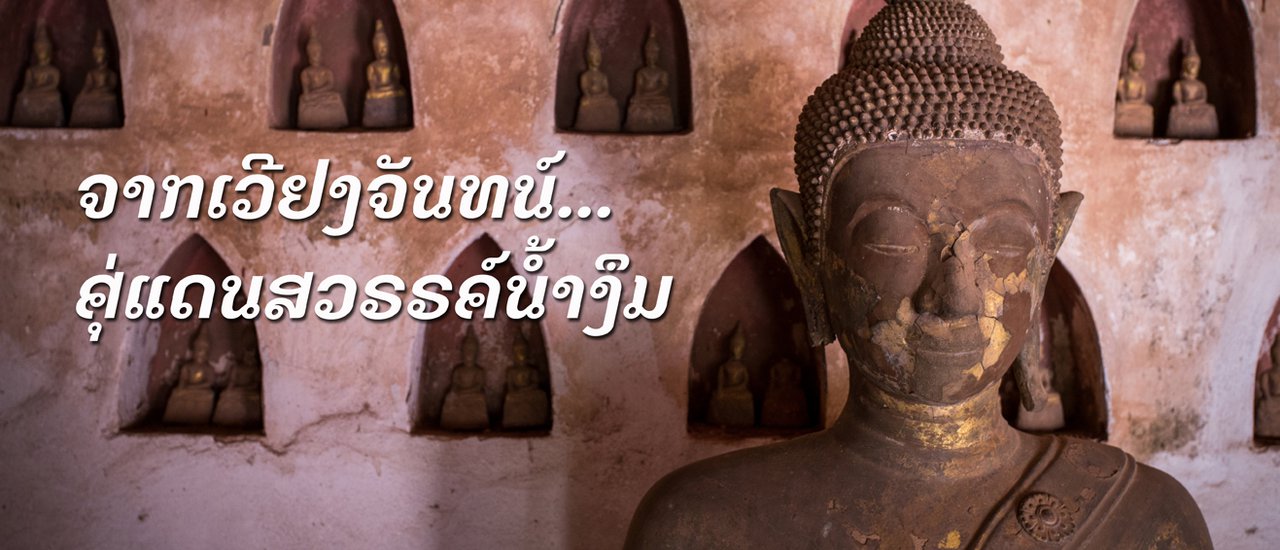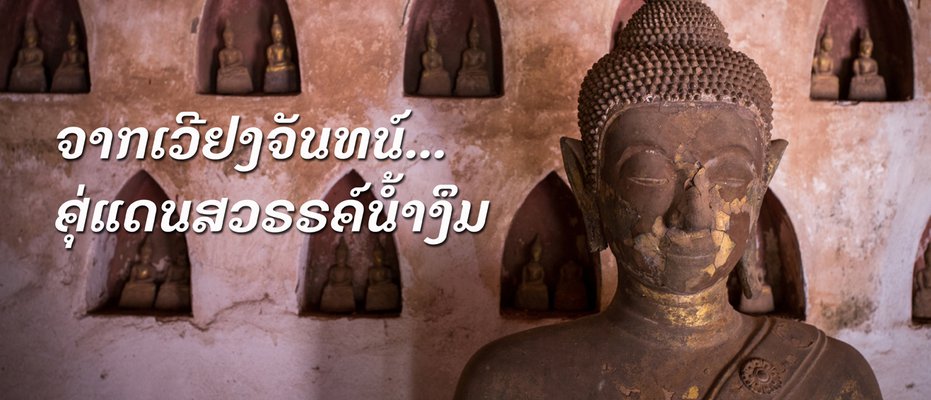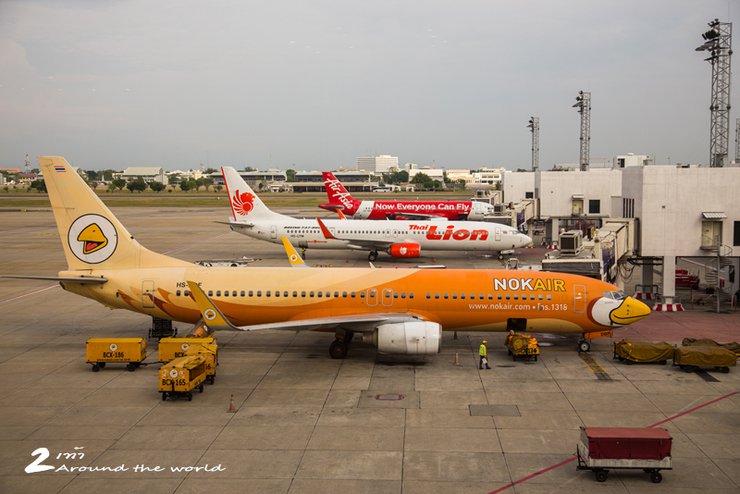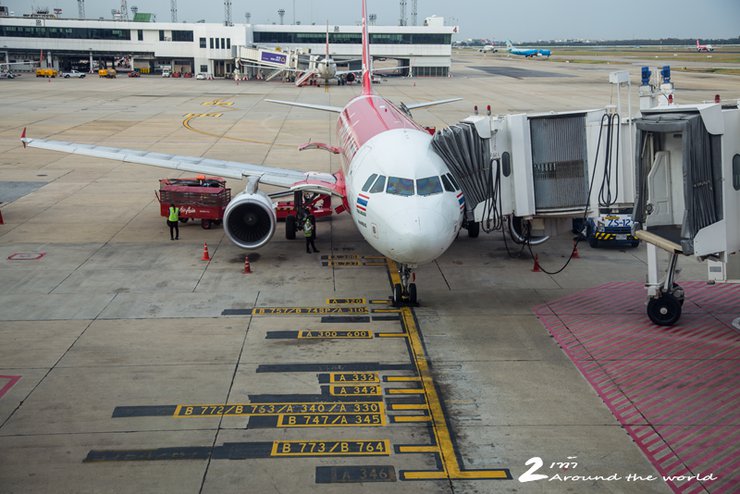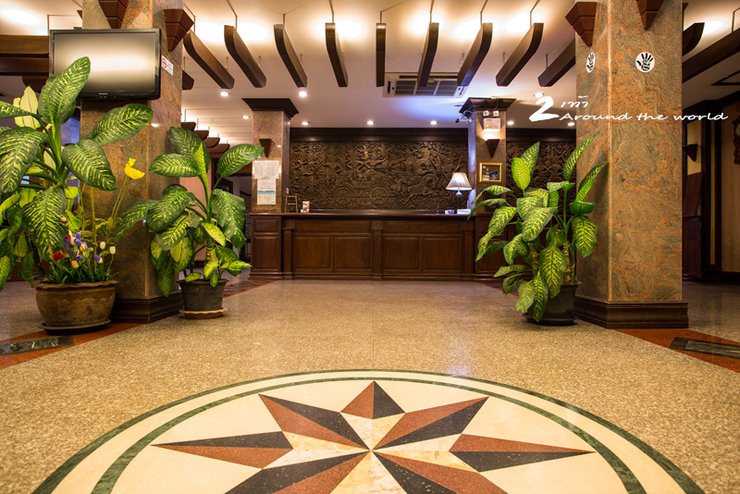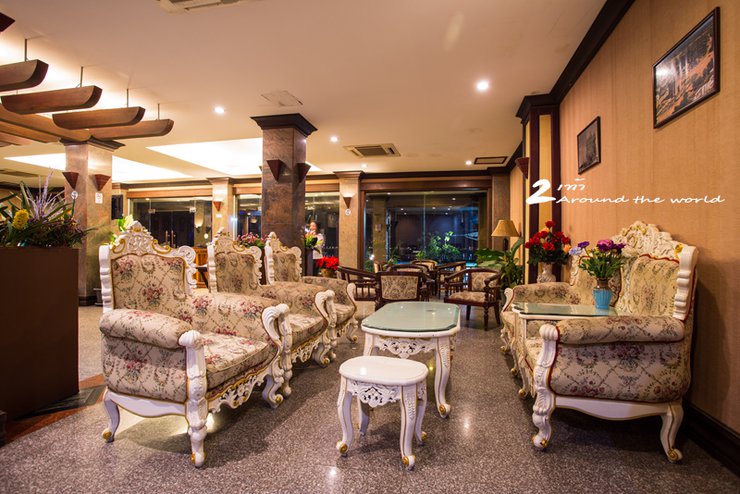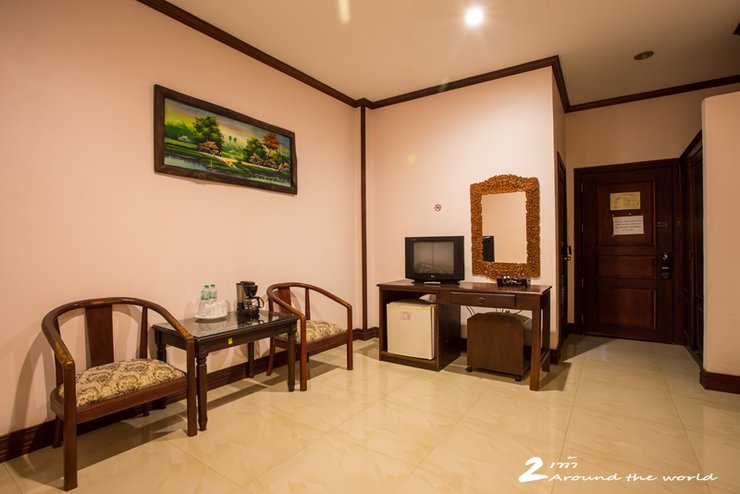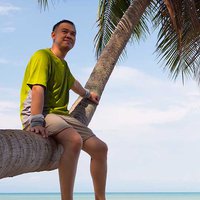
Seeking a weekend getaway, I readily accepted a friend's invitation to explore the idyllic Dan Saeng Ngum Resort. Having never visited before, I eagerly embarked on this spontaneous adventure.
This trip is a 3-day, 2-night itinerary. The rough plan is to travel in the evening after work and fly to Udon Thani. Then, take a car to Vientiane and stay overnight. In the morning, explore Vientiane and in the afternoon, head to Dan Sa Wanh Ngum Resort for an overnight stay. On the last day, travel back.
AirAsia offers one direct flight to Vientiane daily. However, the flight arrives in Vientiane at 13:15, leaving only about 25 hours to explore the city. To make the most of the trip, I chose to travel on a Friday evening, giving me time to explore on Saturday morning.

It's rare to see three airlines gathered together like this.

For this trip, I chose to fly with AirAsia.
Upon arrival at the airport, Fluke contacted a Lao van driver to pick them up at Udon Thani Airport. Once all members had collected their luggage, they headed to Vientiane.
Normally, when visiting Vientiane in the morning, there are people who will assist with border crossing procedures. You simply need to provide a photograph, fill out a temporary border pass form, and pay a small fee. Then, you can wait comfortably until you are cleared through immigration. However, this time, I had to handle everything myself. This was my first time entering Laos using a passport, and there were some minor hiccups. There were requests for overtime payments from the officials, and it took a considerable amount of time to get through.
After completing immigration procedures, I headed straight to my accommodation, as it was already dark and there was nowhere to visit. I decided to save my energy for sightseeing early the next morning.
This evening, I am staying at the Sunray Hotel, which is conveniently located right across from the Mekong River.

Lobby area.

There is a space for guests to relax.
Let's take a look at the rooms.

The space is divided into two sections. The first section, upon entering the room, is a spacious living area for relaxation.

The living room area includes a bathroom. The bathroom is relatively small and does not have a shower. It is equipped with a sink and a toilet.

Adjacent to the living area is the bedroom.

The bedroom also includes an en-suite bathroom for showering.

The evening atmosphere in front of the hotel offers a breathtaking view of the Mekong River stretching as far as the eye can see. The riverbanks are lined with numerous restaurants, creating a vibrant and lively ambiance.

I also came to eat at the restaurant in front of the hotel. There are many restaurants to choose from in this area, and it is very lively.



While waiting for my meal, I took a quick stroll to the nearby walking street. However, as it was quite late, many shops were already closed. I managed to find a few souvenir shops still open and bought several fabric bags as gifts. I tried my best to bargain, but the vendors wouldn't budge on the price. Nevertheless, it was still within my budget, so I decided to purchase them.
After finishing dinner, I crossed the street and walked straight to my accommodation. It was very convenient. If you are visiting Vientiane and looking for a place to stay, this is a great option. The price per room is around 1,500 baht, including breakfast.
The cost of living in Laos is slightly higher than in Thailand, especially for food and accommodation.
I went for a walk early in the morning to enjoy the fresh air.


The riverbank is lined with sunflowers, creating a beautiful vista. Many people come here to stroll or cycle for exercise. The morning air is truly refreshing.


This can be considered a freshwater beach, as it is located on the banks of the Mekong River.

The hotel was dark when I arrived last night, so I didn't see the front. This morning, I took a picture of the front of the hotel.

The top floor of the hotel houses a restaurant with a balcony offering stunning views.

Food is not plentiful. Fluke said not to eat too much. He will take us to eat pho later.

From the balcony, a long stretch of sandy beach is visible. Across the river, on the Thai side, the Mekong River serves as the border.
Following the appetizers at the hotel, we moved on to a hearty breakfast. Fluke suggested a restaurant called "Pho Maephim."

The restaurant is located in a narrow alley, so be sure to keep an eye out for it.

The cooks in the front of the shop are diligently preparing pho.

The pho's flavor is excellent, and the broth is delicious. However, a word of caution: the portions here are quite large. Even the regular size pho I ordered came in a massive bowl. If you order the large size, it could easily feed two people. This bowl of pho costs 80 baht.
Before embarking on a journey to Vientiane, let's delve into its rich history. Vientiane, a city steeped in antiquity, served as the capital of the Lan Xang Kingdom for over 1,200 years. In 1560, King Setthathirath relocated the capital from Luang Prabang to Vientiane, establishing it as the kingdom's new administrative center. Vientiane, formerly known as "Nakhone Chandaburi Sri Sattanakhanahut Utmrattanathipuri," has been a symbol of the Lan Xang Kingdom's legacy ever since.
The majority of tourist attractions in Vientiane are religious sites, with Wat Ong Teu Mahawihan being the first temple to visit.






The most notable feature of Wat Ong Tue Worawihan is its large ordination hall, which houses the principal Buddha image, Phra Chao Yai Tue. This image was commissioned by King Chaiya Chettha in 1566 and is accompanied by the Phra Suk, Phra Sai, and Phra Soem images.
From Wat Ong Tue Worawihan, we continue to the Emerald Buddha Temple.
The **Emerald Buddha Temple**, originally known as **"Ho Phra Kaew"**, was the royal temple of the Laotian monarchy. King Chaiya Chettha of Lan Xang commissioned its construction in 1565 to house the Emerald Buddha, which he had brought from Chiang Mai in the Lanna Kingdom. During the reign of King Nangklao of Siam, the Laotian kingdom became a tributary state of Siam. Prince Anu of Vientiane conspired to break away from Siam and attacked the northeastern Siamese cities. After Siam's victory, Prince Anu was executed, and Vientiane was burned to the ground, with the exception of the Emerald Buddha Temple and Wat Si Saket.
The Emerald Buddha was originally enshrined in the Ho Phra Kaew. However, the Siamese army later seized the Emerald Buddha, a sacred palladium of Vientiane, leaving the Ho Phra Kaew empty to this day. The Emerald Buddha remains a significant religious icon for the Lan Xang people.




The outer terrace of the Ho Phra Kaew houses several ancient bronze Buddha statues in the Lanna style. The oldest statue is a standing stone Buddha in the preaching posture, one of the oldest examples of Chenla art in Asia. It is located near the back door of the Ho Phra Kaew.
Although the Emerald Buddha is no longer housed within the Ho Phra Kaew, it still contains a collection of priceless ancient Buddha statues and artifacts. These include a beautifully carved and gilded wooden standing Buddha statue, a seven-headed naga adorned in full regalia made of bronze in the Lan Xang style, the large main Buddha statue known as "Phra Chao Sakkodom Phutthasimma," and the baldachin that once held the Emerald Buddha. These are displayed in a museum format within the Ho Phra Kaew itself. Photography is not permitted inside. The entrance fee for the Ho Phra Kaew is 10,000 kip.
Adjacent to the Emerald Buddha Temple is Wat Si Sa Ket, another temple that survived the Siamese burning.





Wat Si Saket: A Treasure Trove of Buddha Images
Wat Si Saket, also known as Wat Saen by the Lao people, is a royal temple built by King Sai Setthathirath. It houses countless Buddha statues, both large and small, throughout the surrounding galleries and within the ordination hall, earning it the name "Wat Saen" (Temple of a Hundred Thousand). It is believed to be the temple with the most Buddha images in Laos.
The interior of the viharn (chapel) features a Lan Xang-style Buddha statue. The walls are adorned with small niches containing miniature Buddha images and murals depicting the Ten Jataka tales. Photography is not permitted inside the viharn. The entrance fee for Wat Si Saket is 10,000 kip.
From Wat Si Sa Ket, we continue to Wat Si Mueang.




"Wat Si Muang" was built in 2106 CE but was destroyed by the Siamese army in 2371 CE. A new Wat Si Muang was built in 2458 CE. Wat Si Muang is another temple where many Lao people come to worship. Inside is the main pillar of Vientiane, which is believed to be guarded by the goddess Si Muang, who watches over the happiness and suffering of the people. It is also home to sacred and ancient Buddha statues of Vientiane.

From Wat Si Muang, we continue to the **"That Dam"**, a large octagonal bell-shaped stupa, the only one of its kind in Vientiane. Its style resembles octagonal-based stupas found in Ayutthaya and Lanna art. Originally, the stupa was covered in gold, but it was stripped during the war when Siam captured Vientiane. Hence, it has been called That Dam (Black Stupa) ever since. Legend has it that the area around the stupa is a passage to the underworld, where the 7-headed Naga helped the townspeople during the war against the Siamese army.
From the Black Monument, continue to the Victory Monument, which is not far away.


When I think of Vientiane, I often think of the **Patuxai**. This large triumphal arch was built in 1969 to commemorate the Lao people who died in the wars before the communist revolution. The architecture of the Patuxai is influenced by the Arc de Triomphe in Paris, France, but it also incorporates elements of Laotian art, such as the castle-like spires on the arch, the stucco reliefs of apsaras, and the murals on the ceiling. If you have the energy, I recommend climbing to the top of the Patuxai. The view from the top is beautiful. I climbed it once, but it was too hot this time, so I didn't go up and I don't have any pictures to share.
From Patuxai, continue to That Luang Vientiane.




The **Pha That Luang**, a national symbol of Laos, is believed to have been built around the 13th-14th centuries during the Sri Khotrabong Kingdom. Initially a small stupa named **Pha That Sri Dharmaraja**, it enshrined a relic of the Buddha's right collarbone. In 1566, King Sai Setthathirath constructed a new stupa encasing the original one, naming it **Pha That Luang**, meaning "Great Stupa of the Emerald Buddha." Subsequent renovations shaped the stupa according to the cosmology of Mount Meru, featuring a lotus bud-shaped main stupa surrounded by 30 smaller stupas. The Pha That Luang is a contemporary of the **Pha That Phanom** in Nakhon Phanom Province, Thailand. The entrance fee is 10,000 kip.
In front of the stupa, there is a majestic statue of King Chaiya Chettha, the 45th king of Lan Xang, sitting in a dignified pose.


Surrounding the Pha That Luang in Vientiane are Wat Pha That Nua and Wat Pha That Tai. There is also a market selling souvenirs at affordable prices. I must say that the prices are cheaper than those at the walking street. I saw the prices of goods at this market and had to buy another round because I was heartbroken that I bought expensive items from the walking street. The souvenirs include silk skirts, bags made from fabric, Lao-screened shirts, and many other interesting items.
We will take a break for lunch before heading to our next destination, which is quite far from Vientiane city center. For lunch, I will be having my meal at "Napoong Grilled Chicken Restaurant".

The food is in the style of a Thai som tam and grilled chicken restaurant. It starts with a red ant egg salad, which has a large amount of red ant eggs.

The duck laab has a well-balanced flavor.

Steamed white fish with lime. The fish may be a bit small, so the flesh is less, but it is still delicious.

Red ant egg omelet with an abundance of red ant eggs.


The papaya salad family includes papaya salad, Thai salad, and fermented fish salad.

The chicken family has arrived, including both grilled chicken and chicken stew.
The overall flavor of the food was not as strong as I would have liked. The grilled chicken was delicious.
After lunch, we will continue to the Buddha Park.







The Buddha Park, also known as Wat Pa Si Rattanaram, was created by Bunleua Sulilat while he was still in Laos. He later moved back to Thailand and built the Sala Kaew Ku, or Wat Kaek, in Nong Khai province. It is therefore not surprising that the art of both the Buddha Park and the Sala Kaew Ku are similar. Inside the Buddha Park, there are statues of Buddha made of cement, according to the beliefs of Buddhism and Hinduism. There are also statues of humans, gods, animals, demons, Shiva, Vishnu, and many others. I think if you come here at dusk, it will give you a scary atmosphere.


The Pumpkin House is a prominent feature of Suan Phra. Visitors can climb to the top for a panoramic view.

The interior of the pumpkin-shaped building is quite eerie. The stairs leading up are rather narrow and steep, so caution is advised when climbing them.

The exit from the pumpkin-shaped building leading to the viewpoint is quite narrow and could be considered dangerous. There are no railings on the top to prevent falls, so extra caution is required. From the top, you can enjoy a panoramic view of the Buddha Park, including a clear view of the large reclining Buddha, which is 45 meters long and 19 meters high. If you have time in Vientiane, consider visiting the Buddha Park. The entrance fee is 5,000 kip.
From the Royal Garden, I drove more than 90 kilometers to the north of the Nam Ngum Dam, where Dansawan Nam Ngum Resort, my accommodation for tonight, is located.

The road that branches off the main road to enter the Dan Saeng Ngum Resort is a mountain road. There is a viewpoint halfway up the road that offers stunning views of the resort, which is surrounded by pristine nature, including forests, mountains, and rivers.

The mist greets me.

Dan Savanh Ngeum Resort is a lakeside resort with a casino, a joint venture project of Malaysian businessmen worth over 200 million dollars. The resort offers a variety of activities, including a 24-hour casino, a golf course, and water activities such as kayaking, speedboating, and boat tours of the Ngeum Dam. There is also a spa, disco, and karaoke.

In front of the resort.

Lobby area


The lobby is a spacious hall with corridors leading to guest rooms and the casino. As photography is not permitted in the casino area, we will proceed directly to the guest rooms.


The room is quite spacious and comes equipped with all necessary amenities. It also features a dedicated workspace and a relaxation area.

The bathroom is a decent size and doesn't feel cramped. The toilet has a bidet spray, which is a nice touch. Overall, the room has a luxurious feel, in a Laotian style.
The morning air was pleasant, so I went for a walk to take in the surroundings of the resort.

Walking about 300-400 meters, you will see a building under construction. Judging from the hotel's brochure, I guess it will be a Club House with yachts moored at the pier.


The sentence is already in English and does not require translation.
The Club House offers stunning views of the Ngum Dam.






After soaking in the atmosphere for a while, I walked back to the resort's restaurant for a bite to eat. The dining room was quite spacious, and the breakfast buffet had fewer options than the dinner buffet. I noticed a noodle station where they would prepare dishes to order, but the rest of the food was already cooked. One dish that I had never seen on a buffet before was baked sweet potato.

The sentence is already in English and does not require translation.
The noodle soup broth is quite delicious.
After breakfast, I rested in my room for a while longer. When it was time, I traveled to Vientiane again to prepare for my return trip.

For lunch, I entrusted my stomach to Viengsavan Nem Nuong Restaurant. This restaurant is located in Vientiane city center, not far from the National Cultural Hall. It is said that this restaurant is the most famous for Vietnamese food in Vientiane.

Nem nuong is available in small and large sets, which you can choose according to the number of people in your group. However, there are not as many accompanying vegetables as in Vietnam.

The original text is empty. Please provide the text you want me to translate.
Fried spring rolls and shredded pork or spring onion rolls.

The sentence is already in English and does not require translation.
The overall taste was average. In my opinion, the fermented pork sausage I had in Thailand was more delicious.

It's time to say goodbye to Vientiane. For the return trip, I used AirAsia again. There is one flight back to Thailand every day, departing Vientiane at 2:15 PM and arriving at Don Mueang at 3:20 PM.

The flight took approximately one hour, and I arrived safely at Don Mueang Airport.
This is my fourth visit to Vientiane, but this time I feel like I've gotten to know the city much better. I've had the opportunity to experience the culture and lifestyle of the people of Vientiane more than ever before. If you're interested in learning about different cultures and experiencing a different way of life without having to travel far, then Vientiane is the perfect destination for you. It's our neighboring country, located right on the border with Thailand, and it's sure to meet your expectations.
ลุงเสื้อเขียว
Tuesday, October 8, 2024 11:22 AM

